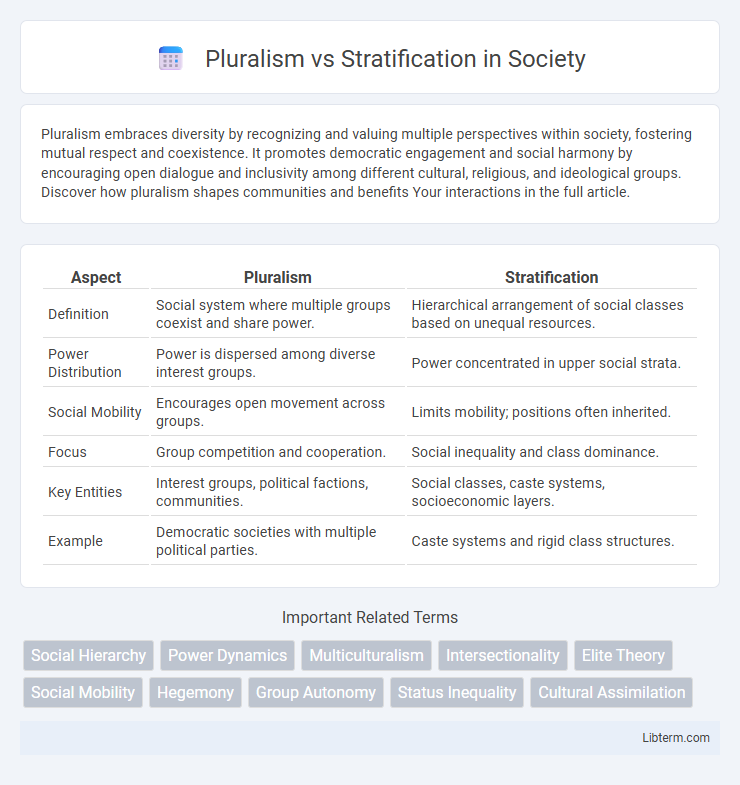Pluralism embraces diversity by recognizing and valuing multiple perspectives within society, fostering mutual respect and coexistence. It promotes democratic engagement and social harmony by encouraging open dialogue and inclusivity among different cultural, religious, and ideological groups. Discover how pluralism shapes communities and benefits Your interactions in the full article.
Table of Comparison
| Aspect | Pluralism | Stratification |
|---|---|---|
| Definition | Social system where multiple groups coexist and share power. | Hierarchical arrangement of social classes based on unequal resources. |
| Power Distribution | Power is dispersed among diverse interest groups. | Power concentrated in upper social strata. |
| Social Mobility | Encourages open movement across groups. | Limits mobility; positions often inherited. |
| Focus | Group competition and cooperation. | Social inequality and class dominance. |
| Key Entities | Interest groups, political factions, communities. | Social classes, caste systems, socioeconomic layers. |
| Example | Democratic societies with multiple political parties. | Caste systems and rigid class structures. |
Understanding Pluralism: Definition and Key Features
Pluralism refers to a social framework where diverse groups coexist with equal access to resources and influence in decision-making processes. Key features of pluralism include the recognition of multiple interests, active participation of various groups in politics, and the contribution of different cultural identities to a dynamic, inclusive society. This concept contrasts with stratification, which emphasizes hierarchical structures and unequal distribution of power and resources among social classes.
The Concept of Stratification: Origins and Meaning
Stratification originated from sociological theories exploring how societies organize individuals into hierarchical layers based on class, status, and power. This concept highlights structured inequalities embedded within social systems, differentiating it from pluralism, which emphasizes diversity and multiple centers of power without inherent hierarchy. Understanding stratification involves analyzing how resources and opportunities are distributed unequally, shaping social mobility and group relations.
Historical Evolution of Pluralism and Stratification
The historical evolution of pluralism highlights the growth of diverse interest groups and the increased recognition of multiple power centers within societies, emphasizing democratic participation and shared influence. Stratification's historical development reveals entrenched social hierarchies based on class, race, and gender, underscoring systemic inequality and power concentration. Understanding these frameworks is essential for analyzing social dynamics and power distribution across different historical contexts.
Core Differences Between Pluralism and Stratification
Pluralism emphasizes the coexistence of diverse groups within a society where power is distributed among multiple competing factions, promoting equal participation and representation. Stratification, by contrast, refers to the hierarchical arrangement of individuals into social layers based on factors like wealth, status, and power, resulting in unequal access to resources and opportunities. The core difference lies in pluralism's focus on diversity and power-sharing versus stratification's emphasis on social inequality and structured dominance.
Social Implications of Pluralistic Societies
Pluralistic societies foster social inclusion by recognizing diverse cultural, ethnic, and religious groups, promoting democratic participation and equal rights. This diversity enhances social cohesion through dialogue and mutual respect, reducing systemic inequalities present in stratified systems. However, maintaining balance requires addressing potential conflicts arising from competing group interests to ensure social stability and collective progress.
Stratified Societies: Structure and Consequences
Stratified societies are characterized by hierarchical social layers where resources, power, and status are unevenly distributed, creating distinct social classes. This structured inequality affects access to education, healthcare, and economic opportunities, reinforcing social divisions and limiting social mobility. The persistence of stratification can lead to systemic disparities in wealth, influence, and quality of life across different social groups.
Pluralism in Modern Democracies
Pluralism in modern democracies emphasizes the distribution of power among diverse interest groups, ensuring that no single entity dominates decision-making processes. This system fosters inclusive political participation and encourages negotiation and compromise among competing factions. By promoting a balanced representation of multiple voices, pluralism enhances responsiveness and accountability within democratic institutions.
Stratification and Social Inequality
Social stratification organizes society into hierarchical layers based on factors such as wealth, power, and prestige, resulting in persistent social inequality. This structured ranking system influences access to resources, opportunities, and privileges, reinforcing disparities across different social groups. Inequality in stratification shapes life chances and perpetuates cycles of poverty, impacting education, health, and economic mobility.
Case Studies: Real-World Examples of Pluralism vs Stratification
Case studies of pluralism reveal diverse societies where multiple cultural groups coexist with equitable access to power, such as Switzerland's multilingual cantons promoting political representation for different language communities. In contrast, stratification is evident in South Africa's apartheid era, where systemic racial segregation enforced hierarchical social divisions, limiting opportunities for non-white populations. These examples highlight how pluralism fosters inclusivity and shared governance, whereas stratification entrenches inequality and social barriers.
Future Trends: Towards Pluralism or Deepening Stratification?
Future trends indicate a complex interplay between pluralism and social stratification, with technological advancements and globalization fostering diverse cultural expressions while economic inequalities persist or worsen. Emerging digital platforms enhance representation of marginalized groups, supporting pluralistic ideals, yet growing wealth gaps and limited access to resources contribute to deepening stratification. Monitoring policy responses to education, healthcare, and digital inclusion will be crucial in determining whether societies move towards greater pluralism or entrenched social hierarchies.
Pluralism Infographic

 libterm.com
libterm.com